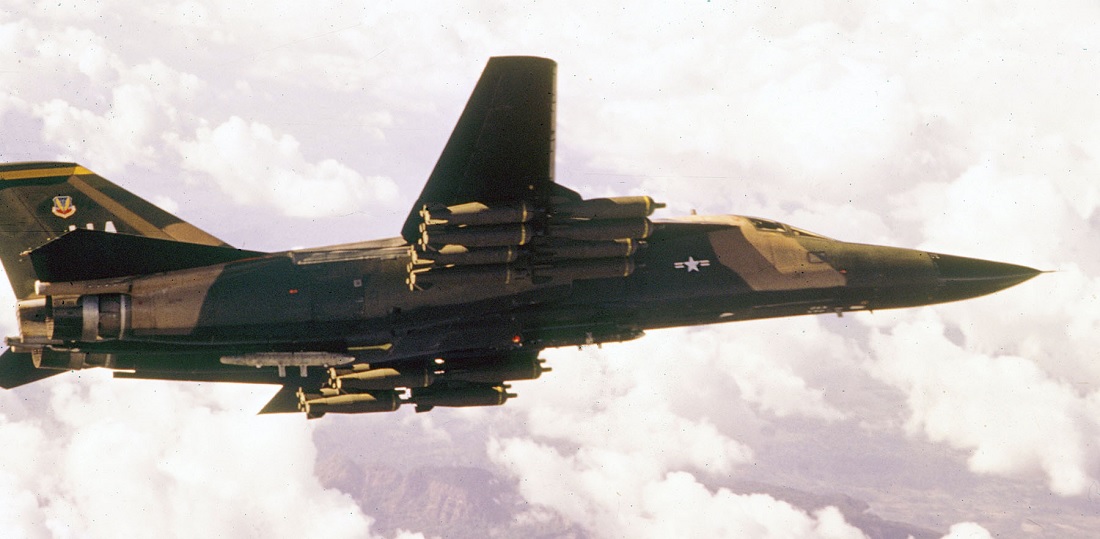On March 25, 1968, the F-111A began its combat career with a night of strikes, starting with a 500kt, 500ft solo attack that fully displayed the F-111A’s prowess
The first Air Force version of the TFX (for “Tactical Fighter Experimental”), the most divisive of all the joint-service “commonality” airplanes developed during the McNamara era, and intended as “cost-effective” substitutes for aircraft acquired through conventional acquisition processes, saw deployment planning begin at PACAF in the fall of 1967.
The F-4, OV-10, and A-7 programs showed that commonality might succeed if it were carefully planned and implemented, but with the TFX, as told by Richard P. Hallon in his book Rolling Thunder 1965-68, McNamara had tried the impossibility of creating a successful aircraft by combining intrinsically incompatible requirements.
Key to meeting all these was a large variable-geometry wing that fully extended to generate the lift necessary to achieve long-range and long-loiter but swept sharply back to reduce drag, permitting a supersonic dash. In 1963, Congressional investigators found that the McNamara team had rejected the recommendations of service and NASA professionals when it selected General Dynamics over a more highly regarded Boeing design.
After being put through rigorous flight testing, the TFX exposed significant performance and safety flaws, many of which required redesign. The Navy was forced to create a replacement, the Grumman F-14A Tomcat, which first flew nearly a decade after the F-4 had first taken to the skies because the F-111B carrier-based variant, which was significantly overweight and dangerously underpowered, never entered fleet service.
Notwithstanding its flaws, the Air Force F-111A program had a lot of potential since it combined attack avionics on par with those of the A-6, a terrain-following radar (TER) coupled to an autopilot, and a low-level supersonic dash similar to that of the F-105. On March 17, 1968, St. Patrick’s Day, Combat Lancer, formally Det 1 of the 428th TFS, a six-aircraft operational test and evaluation force of the Air Force’s new General Dynamics F-111A, landed at Takhli.
On March 25, the F-111A began its combat career with a night of strikes, starting with a solo attack that displayed the aircraft’s prowess to the fullest extent at 500 kt and 500 ft. With an F-111A SN 66-0018, Colonel Ivan Dethman and Captain Rick Matteis departed from Takhli, flew over Nakhon Phanom, and then lowered their altitude to 500 feet in preparation for a strike on the Vung Chua truck park and storage area on Hon Co Island. Before leaving over the Tonkin Gulf, Dethman and Matteis dropped 12 M117 750 lb bombs with drag-retarding fins.
Regrettably, three were lost very quickly—two from mechanical issues and the third from an SA-2—and only one crew was saved. This shoot-down was so critical that then-Soviet military minister Andrei Grechko personally briefed Leonid Brezhnev on it. There was no doubt that the F-111A needed improvement. Despite the arrival of three extra F-111As to make up for lost aircraft, Combat Lancer saw little more action in Southeast Asia before flying back to Nellis AFB in the middle of November 1968. Having reached maturity, the F-111A returned to Vietnam in 1972 and, during Operation Linebacker, proved to be a lethal and extremely effective night attacker.
Almost exactly two decades later, the outstanding F-111F proved to be a pillar of Operation Desert Storm thanks to its increased power and Pave Tack self-designating attack system.
Rolling Thunder 1965-68 is published by Osprey Publishing and is available to order here.

Photo by: U.S. Air Force

